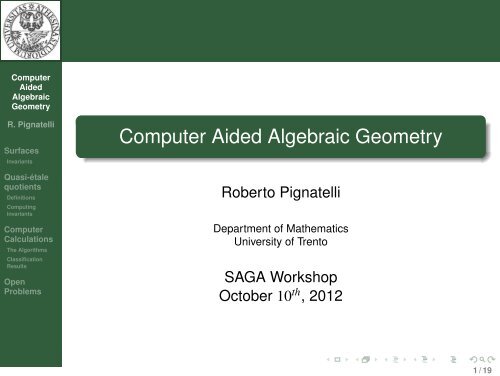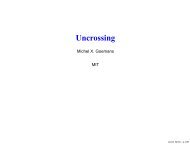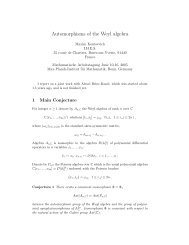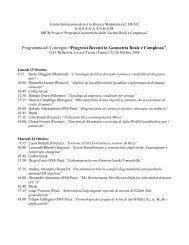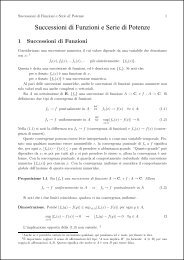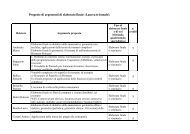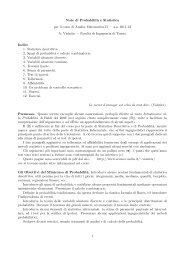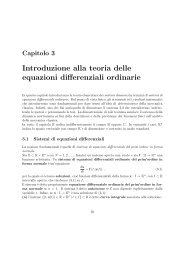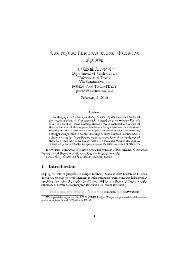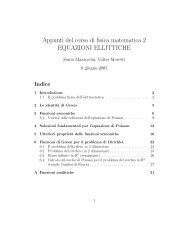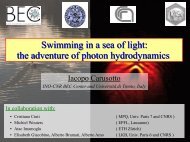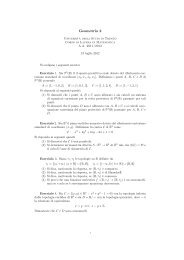Computer Aided Algebraic Geometry
Computer Aided Algebraic Geometry
Computer Aided Algebraic Geometry
Create successful ePaper yourself
Turn your PDF publications into a flip-book with our unique Google optimized e-Paper software.
<strong>Computer</strong><br />
<strong>Aided</strong><br />
<strong>Algebraic</strong><br />
<strong>Geometry</strong><br />
R. Pignatelli<br />
Surfaces<br />
Invariants<br />
Quasi-étale<br />
quotients<br />
Definitions<br />
Computing<br />
invariants<br />
<strong>Computer</strong><br />
Calculations<br />
The Algorithms<br />
Classification<br />
Results<br />
Open<br />
Problems<br />
<strong>Computer</strong> <strong>Aided</strong> <strong>Algebraic</strong> <strong>Geometry</strong><br />
Roberto Pignatelli<br />
Department of Mathematics<br />
University of Trento<br />
SAGA Workshop<br />
October 10 th , 2012<br />
1 / 19
Birational Invariants<br />
<strong>Computer</strong><br />
<strong>Aided</strong><br />
<strong>Algebraic</strong><br />
<strong>Geometry</strong><br />
R. Pignatelli<br />
Definition<br />
A surface is a projective compact complex manifold of<br />
dimension 2.<br />
Surfaces<br />
Invariants<br />
Quasi-étale<br />
quotients<br />
Definitions<br />
Computing<br />
invariants<br />
<strong>Computer</strong><br />
Calculations<br />
The Algorithms<br />
Classification<br />
Results<br />
Open<br />
Problems<br />
2 / 19
Birational Invariants<br />
<strong>Computer</strong><br />
<strong>Aided</strong><br />
<strong>Algebraic</strong><br />
<strong>Geometry</strong><br />
R. Pignatelli<br />
Surfaces<br />
Invariants<br />
Quasi-étale<br />
quotients<br />
Definitions<br />
Definition<br />
A surface is a projective compact complex manifold of<br />
dimension 2.<br />
We look at surfaces modulo birational equivalence, the<br />
equivalence relation generated by the blow-up in a point.<br />
Computing<br />
invariants<br />
<strong>Computer</strong><br />
Calculations<br />
The Algorithms<br />
Classification<br />
Results<br />
Open<br />
Problems<br />
2 / 19
Birational Invariants<br />
<strong>Computer</strong><br />
<strong>Aided</strong><br />
<strong>Algebraic</strong><br />
<strong>Geometry</strong><br />
R. Pignatelli<br />
Surfaces<br />
Invariants<br />
Quasi-étale<br />
quotients<br />
Definitions<br />
Computing<br />
invariants<br />
<strong>Computer</strong><br />
Calculations<br />
The Algorithms<br />
Classification<br />
Results<br />
Definition<br />
A surface is a projective compact complex manifold of<br />
dimension 2.<br />
We look at surfaces modulo birational equivalence, the<br />
equivalence relation generated by the blow-up in a point.<br />
The classical birational invariants are<br />
• the geometric genus<br />
p g (S) = h 2,0 (S) = h 0 (Ω 2 S ) = h0 (O S (K S )) = h 2 (O S ).<br />
Open<br />
Problems<br />
2 / 19
Birational Invariants<br />
<strong>Computer</strong><br />
<strong>Aided</strong><br />
<strong>Algebraic</strong><br />
<strong>Geometry</strong><br />
R. Pignatelli<br />
Surfaces<br />
Invariants<br />
Quasi-étale<br />
quotients<br />
Definitions<br />
Computing<br />
invariants<br />
<strong>Computer</strong><br />
Calculations<br />
The Algorithms<br />
Classification<br />
Results<br />
Open<br />
Problems<br />
Definition<br />
A surface is a projective compact complex manifold of<br />
dimension 2.<br />
We look at surfaces modulo birational equivalence, the<br />
equivalence relation generated by the blow-up in a point.<br />
The classical birational invariants are<br />
• the geometric genus<br />
p g (S) = h 2,0 (S) = h 0 (Ω 2 S ) = h0 (O S (K S )) = h 2 (O S ).<br />
• the irregularity q(S) = h 1,0 (S) = h 0 (Ω 1 S ) = h1 (O S ).<br />
2 / 19
Birational Invariants<br />
<strong>Computer</strong><br />
<strong>Aided</strong><br />
<strong>Algebraic</strong><br />
<strong>Geometry</strong><br />
R. Pignatelli<br />
Surfaces<br />
Invariants<br />
Quasi-étale<br />
quotients<br />
Definitions<br />
Computing<br />
invariants<br />
<strong>Computer</strong><br />
Calculations<br />
The Algorithms<br />
Classification<br />
Results<br />
Open<br />
Problems<br />
Definition<br />
A surface is a projective compact complex manifold of<br />
dimension 2.<br />
We look at surfaces modulo birational equivalence, the<br />
equivalence relation generated by the blow-up in a point.<br />
The classical birational invariants are<br />
• the geometric genus<br />
p g (S) = h 2,0 (S) = h 0 (Ω 2 S ) = h0 (O S (K S )) = h 2 (O S ).<br />
• the irregularity q(S) = h 1,0 (S) = h 0 (Ω 1 S ) = h1 (O S ).<br />
• the Euler characteristic χ = χ(O S ) = 1 − q + p g .<br />
2 / 19
Birational Invariants<br />
<strong>Computer</strong><br />
<strong>Aided</strong><br />
<strong>Algebraic</strong><br />
<strong>Geometry</strong><br />
R. Pignatelli<br />
Surfaces<br />
Invariants<br />
Quasi-étale<br />
quotients<br />
Definitions<br />
Computing<br />
invariants<br />
<strong>Computer</strong><br />
Calculations<br />
The Algorithms<br />
Classification<br />
Results<br />
Open<br />
Problems<br />
Definition<br />
A surface is a projective compact complex manifold of<br />
dimension 2.<br />
We look at surfaces modulo birational equivalence, the<br />
equivalence relation generated by the blow-up in a point.<br />
The classical birational invariants are<br />
• the geometric genus<br />
p g (S) = h 2,0 (S) = h 0 (Ω 2 S ) = h0 (O S (K S )) = h 2 (O S ).<br />
• the irregularity q(S) = h 1,0 (S) = h 0 (Ω 1 S ) = h1 (O S ).<br />
• the Euler characteristic χ = χ(O S ) = 1 − q + p g .<br />
• The plurigenera P n (S) = h 0 (O S (nK S )).<br />
2 / 19
Birational Invariants<br />
<strong>Computer</strong><br />
<strong>Aided</strong><br />
<strong>Algebraic</strong><br />
<strong>Geometry</strong><br />
R. Pignatelli<br />
Surfaces<br />
Invariants<br />
Quasi-étale<br />
quotients<br />
Definitions<br />
Computing<br />
invariants<br />
<strong>Computer</strong><br />
Calculations<br />
The Algorithms<br />
Classification<br />
Results<br />
Open<br />
Problems<br />
Definition<br />
A surface is a projective compact complex manifold of<br />
dimension 2.<br />
We look at surfaces modulo birational equivalence, the<br />
equivalence relation generated by the blow-up in a point.<br />
The classical birational invariants are<br />
• the geometric genus<br />
p g (S) = h 2,0 (S) = h 0 (Ω 2 S ) = h0 (O S (K S )) = h 2 (O S ).<br />
• the irregularity q(S) = h 1,0 (S) = h 0 (Ω 1 S ) = h1 (O S ).<br />
• the Euler characteristic χ = χ(O S ) = 1 − q + p g .<br />
• The plurigenera P n (S) = h 0 (O S (nK S )).<br />
• The Kodaira dimension κ(S) is the rate of growth of the<br />
plurigenera: it is the smallest number κ such that P n /n κ<br />
is bounded from above.<br />
2 / 19
Surfaces of general type<br />
<strong>Computer</strong><br />
<strong>Aided</strong><br />
<strong>Algebraic</strong><br />
<strong>Geometry</strong><br />
R. Pignatelli<br />
Surfaces<br />
Invariants<br />
Quasi-étale<br />
quotients<br />
Definitions<br />
The Enriques-Kodaira classification provides a relatively<br />
good understanding of the surfaces of special type, which<br />
are those with κ(S) < 2.<br />
Definition<br />
A surface is of general type if κ(S) = 2 (equiv.κ(S) ≥ 2) .<br />
Computing<br />
invariants<br />
<strong>Computer</strong><br />
Calculations<br />
The Algorithms<br />
Classification<br />
Results<br />
Open<br />
Problems<br />
3 / 19
Surfaces of general type<br />
<strong>Computer</strong><br />
<strong>Aided</strong><br />
<strong>Algebraic</strong><br />
<strong>Geometry</strong><br />
R. Pignatelli<br />
Surfaces<br />
Invariants<br />
Quasi-étale<br />
quotients<br />
Definitions<br />
Computing<br />
invariants<br />
<strong>Computer</strong><br />
Calculations<br />
The Algorithms<br />
Classification<br />
Results<br />
The Enriques-Kodaira classification provides a relatively<br />
good understanding of the surfaces of special type, which<br />
are those with κ(S) < 2.<br />
Definition<br />
A surface is of general type if κ(S) = 2 (equiv.κ(S) ≥ 2) .<br />
Definition<br />
A surface is minimal if K S is nef, that is if the intersection of<br />
K S with any curve is nonnegative.<br />
Open<br />
Problems<br />
3 / 19
Surfaces of general type<br />
<strong>Computer</strong><br />
<strong>Aided</strong><br />
<strong>Algebraic</strong><br />
<strong>Geometry</strong><br />
R. Pignatelli<br />
Surfaces<br />
Invariants<br />
Quasi-étale<br />
quotients<br />
Definitions<br />
Computing<br />
invariants<br />
<strong>Computer</strong><br />
Calculations<br />
The Algorithms<br />
Classification<br />
Results<br />
Open<br />
Problems<br />
The Enriques-Kodaira classification provides a relatively<br />
good understanding of the surfaces of special type, which<br />
are those with κ(S) < 2.<br />
Definition<br />
A surface is of general type if κ(S) = 2 (equiv.κ(S) ≥ 2) .<br />
Definition<br />
A surface is minimal if K S is nef, that is if the intersection of<br />
K S with any curve is nonnegative.<br />
In every birational class of surfaces of general type there is<br />
exactly one minimal surface. If S is a surface of general<br />
type, S is obtained by the only minimal surface ¯S in its<br />
birational class by a sequence of K 2¯S − K2 S blow ups. 3 / 19
M. Noether conjecture<br />
<strong>Computer</strong><br />
<strong>Aided</strong><br />
<strong>Algebraic</strong><br />
<strong>Geometry</strong><br />
R. Pignatelli<br />
At the end of the XIX th century M. Noether conjectured that<br />
every surface with p g = 0 be birational to P 2 .<br />
Surfaces<br />
Invariants<br />
Quasi-étale<br />
quotients<br />
Definitions<br />
Computing<br />
invariants<br />
<strong>Computer</strong><br />
Calculations<br />
The Algorithms<br />
Classification<br />
Results<br />
Open<br />
Problems<br />
4 / 19
M. Noether conjecture<br />
<strong>Computer</strong><br />
<strong>Aided</strong><br />
<strong>Algebraic</strong><br />
<strong>Geometry</strong><br />
R. Pignatelli<br />
Surfaces<br />
Invariants<br />
At the end of the XIX th century M. Noether conjectured that<br />
every surface with p g = 0 be birational to P 2 .<br />
The first counterexample was done by Enriques few years<br />
later.<br />
Quasi-étale<br />
quotients<br />
Definitions<br />
Computing<br />
invariants<br />
<strong>Computer</strong><br />
Calculations<br />
The Algorithms<br />
Classification<br />
Results<br />
Open<br />
Problems<br />
4 / 19
M. Noether conjecture<br />
<strong>Computer</strong><br />
<strong>Aided</strong><br />
<strong>Algebraic</strong><br />
<strong>Geometry</strong><br />
R. Pignatelli<br />
Surfaces<br />
Invariants<br />
Quasi-étale<br />
quotients<br />
Definitions<br />
At the end of the XIX th century M. Noether conjectured that<br />
every surface with p g = 0 be birational to P 2 .<br />
The first counterexample was done by Enriques few years<br />
later. The first counterexamples of general type were done<br />
in the ′ 30s by Godeaux and Campedelli.<br />
Computing<br />
invariants<br />
<strong>Computer</strong><br />
Calculations<br />
The Algorithms<br />
Classification<br />
Results<br />
Open<br />
Problems<br />
4 / 19
M. Noether conjecture<br />
<strong>Computer</strong><br />
<strong>Aided</strong><br />
<strong>Algebraic</strong><br />
<strong>Geometry</strong><br />
R. Pignatelli<br />
Surfaces<br />
Invariants<br />
Quasi-étale<br />
quotients<br />
Definitions<br />
Computing<br />
invariants<br />
<strong>Computer</strong><br />
Calculations<br />
The Algorithms<br />
Classification<br />
Results<br />
Open<br />
Problems<br />
At the end of the XIX th century M. Noether conjectured that<br />
every surface with p g = 0 be birational to P 2 .<br />
The first counterexample was done by Enriques few years<br />
later. The first counterexamples of general type were done<br />
in the ′ 30s by Godeaux and Campedelli.<br />
Surfaces of general type with p g = 0 have been very useful<br />
to construct counterxamples in many different fields<br />
(Kähler-Einsten metrics, complex structures on real<br />
manifolds, Chow groups, Phantoms, ...).<br />
4 / 19
M. Noether conjecture<br />
<strong>Computer</strong><br />
<strong>Aided</strong><br />
<strong>Algebraic</strong><br />
<strong>Geometry</strong><br />
R. Pignatelli<br />
Surfaces<br />
Invariants<br />
Quasi-étale<br />
quotients<br />
Definitions<br />
Computing<br />
invariants<br />
<strong>Computer</strong><br />
Calculations<br />
The Algorithms<br />
Classification<br />
Results<br />
Open<br />
Problems<br />
At the end of the XIX th century M. Noether conjectured that<br />
every surface with p g = 0 be birational to P 2 .<br />
The first counterexample was done by Enriques few years<br />
later. The first counterexamples of general type were done<br />
in the ′ 30s by Godeaux and Campedelli.<br />
Surfaces of general type with p g = 0 have been very useful<br />
to construct counterxamples in many different fields<br />
(Kähler-Einsten metrics, complex structures on real<br />
manifolds, Chow groups, Phantoms, ...).<br />
Still, they are very very difficult to construct; ten years ago<br />
we had only a couple of dozens of constructions.<br />
4 / 19
Inequalities for surfaces of general type<br />
<strong>Computer</strong><br />
<strong>Aided</strong><br />
<strong>Algebraic</strong><br />
<strong>Geometry</strong><br />
If S is of general type, then the Riemann-Roch formula<br />
computes all P n (S) from χ and K 2¯S . 5 / 19<br />
R. Pignatelli<br />
Surfaces<br />
Invariants<br />
Quasi-étale<br />
quotients<br />
Definitions<br />
Computing<br />
invariants<br />
<strong>Computer</strong><br />
Calculations<br />
The Algorithms<br />
Classification<br />
Results<br />
Open<br />
Problems
5 / 19<br />
Inequalities for surfaces of general type<br />
<strong>Computer</strong><br />
<strong>Aided</strong><br />
<strong>Algebraic</strong><br />
<strong>Geometry</strong><br />
R. Pignatelli<br />
Surfaces<br />
Invariants<br />
If S is of general type, then the Riemann-Roch formula<br />
computes all P n (S) from χ and K .The possible values of the<br />
2¯S<br />
pair (χ, K ) are almost all the integral points of the<br />
2¯S<br />
unbounded green region below.<br />
Quasi-étale<br />
quotients<br />
Definitions<br />
Computing<br />
invariants<br />
<strong>Computer</strong><br />
Calculations<br />
The Algorithms<br />
Classification<br />
Results<br />
Open<br />
Problems
Beauville construction<br />
<strong>Computer</strong><br />
<strong>Aided</strong><br />
<strong>Algebraic</strong><br />
<strong>Geometry</strong><br />
R. Pignatelli<br />
Surfaces<br />
Invariants<br />
Beauville suggestion: take S = (C 1 × C 2 )/G where C i are<br />
Riemann Surfaces of genus g i ≥ 2 and G is a group of order<br />
(g 1 − 1)(g 2 − 1) acting freely; S is automatically minimal of<br />
general type with χ = 1 and K 2 = 8.<br />
Quasi-étale<br />
quotients<br />
Definitions<br />
Computing<br />
invariants<br />
<strong>Computer</strong><br />
Calculations<br />
The Algorithms<br />
Classification<br />
Results<br />
Open<br />
Problems<br />
6 / 19
Surfaces isogenous to a product<br />
<strong>Computer</strong><br />
<strong>Aided</strong><br />
<strong>Algebraic</strong><br />
<strong>Geometry</strong><br />
R. Pignatelli<br />
Surfaces<br />
Invariants<br />
A surface is isogenous to a (higher) product if<br />
S = (C 1 × C 2 )/G where C i are Riemann Surfaces of genus<br />
g i ≥ 2 and G is a group acting freely; S is automatically<br />
minimal of general type with K 2 = 8χ.<br />
Quasi-étale<br />
quotients<br />
Definitions<br />
Computing<br />
invariants<br />
<strong>Computer</strong><br />
Calculations<br />
The Algorithms<br />
Classification<br />
Results<br />
Open<br />
Problems<br />
7 / 19
Quasi-étale quotients<br />
<strong>Computer</strong><br />
<strong>Aided</strong><br />
<strong>Algebraic</strong><br />
<strong>Geometry</strong><br />
R. Pignatelli<br />
Surfaces<br />
Invariants<br />
Quasi-étale<br />
quotients<br />
Definitions<br />
Definition<br />
A quasi-étale surface is<br />
X = (C 1 × C 2 )/G where C i are Riemann Surfaces of genus<br />
g i ≥ 2 and G is a group of automorphisms acting freely out<br />
of a finite set of points.<br />
Computing<br />
invariants<br />
<strong>Computer</strong><br />
Calculations<br />
The Algorithms<br />
Classification<br />
Results<br />
Open<br />
Problems<br />
8 / 19
Quasi-étale quotients<br />
<strong>Computer</strong><br />
<strong>Aided</strong><br />
<strong>Algebraic</strong><br />
<strong>Geometry</strong><br />
R. Pignatelli<br />
Surfaces<br />
Invariants<br />
Quasi-étale<br />
quotients<br />
Definitions<br />
Computing<br />
invariants<br />
<strong>Computer</strong><br />
Calculations<br />
The Algorithms<br />
Definition<br />
A quasi-étale surface is<br />
X = (C 1 × C 2 )/G where C i are Riemann Surfaces of genus<br />
g i ≥ 2 and G is a group of automorphisms acting freely out<br />
of a finite set of points.<br />
If π : C 1 × C 2 → X is the quotient map, we are assuming π<br />
quasi-étale (instead of étale).<br />
Classification<br />
Results<br />
Open<br />
Problems<br />
8 / 19
Quasi-étale quotients<br />
<strong>Computer</strong><br />
<strong>Aided</strong><br />
<strong>Algebraic</strong><br />
<strong>Geometry</strong><br />
R. Pignatelli<br />
Surfaces<br />
Invariants<br />
Quasi-étale<br />
quotients<br />
Definitions<br />
Computing<br />
invariants<br />
<strong>Computer</strong><br />
Calculations<br />
The Algorithms<br />
Classification<br />
Results<br />
Open<br />
Problems<br />
Definition<br />
A quasi-étale surface is<br />
X = (C 1 × C 2 )/G where C i are Riemann Surfaces of genus<br />
g i ≥ 2 and G is a group of automorphisms acting freely out<br />
of a finite set of points.<br />
If π : C 1 × C 2 → X is the quotient map, we are assuming π<br />
quasi-étale (instead of étale).<br />
• What we lose: X is singular, we need to consider a<br />
resolution of its singularities S.<br />
8 / 19
Quasi-étale quotients<br />
<strong>Computer</strong><br />
<strong>Aided</strong><br />
<strong>Algebraic</strong><br />
<strong>Geometry</strong><br />
R. Pignatelli<br />
Surfaces<br />
Invariants<br />
Quasi-étale<br />
quotients<br />
Definitions<br />
Computing<br />
invariants<br />
<strong>Computer</strong><br />
Calculations<br />
The Algorithms<br />
Classification<br />
Results<br />
Open<br />
Problems<br />
Definition<br />
A quasi-étale surface is the min. res. S of the sings of<br />
X = (C 1 × C 2 )/G where C i are Riemann Surfaces of genus<br />
g i ≥ 2 and G is a group of automorphisms acting freely out<br />
of a finite set of points.<br />
If π : C 1 × C 2 → X is the quotient map, we are assuming π<br />
quasi-étale (instead of étale).<br />
• What we lose: X is singular, we need to consider a<br />
resolution of its singularities S.<br />
8 / 19
Quasi-étale quotients<br />
<strong>Computer</strong><br />
<strong>Aided</strong><br />
<strong>Algebraic</strong><br />
<strong>Geometry</strong><br />
R. Pignatelli<br />
Surfaces<br />
Invariants<br />
Quasi-étale<br />
quotients<br />
Definitions<br />
Computing<br />
invariants<br />
<strong>Computer</strong><br />
Calculations<br />
The Algorithms<br />
Classification<br />
Results<br />
Open<br />
Problems<br />
Definition<br />
A quasi-étale surface is the min. res. S of the sings of<br />
X = (C 1 × C 2 )/G where C i are Riemann Surfaces of genus<br />
g i ≥ 2 and G is a group of automorphisms acting freely out<br />
of a finite set of points.<br />
If π : C 1 × C 2 → X is the quotient map, we are assuming π<br />
quasi-étale (instead of étale).<br />
• What we lose: X is singular, we need to consider a<br />
resolution of its singularities S.<br />
• What we gain: It may be K 2 < 8χ. We may in principle<br />
fill most of the picture.<br />
8 / 19
Quasi-étale quotients<br />
<strong>Computer</strong><br />
<strong>Aided</strong><br />
<strong>Algebraic</strong><br />
<strong>Geometry</strong><br />
R. Pignatelli<br />
Surfaces<br />
Invariants<br />
It may be K 2 < 8χ. We may in principle fill most of the<br />
picture.<br />
This gives a powerful tool to answer (positively) existence<br />
conjectures.<br />
Quasi-étale<br />
quotients<br />
Definitions<br />
Computing<br />
invariants<br />
<strong>Computer</strong><br />
Calculations<br />
The Algorithms<br />
Classification<br />
Results<br />
Open<br />
Problems<br />
9 / 19
Mixed and unmixed structures<br />
<strong>Computer</strong><br />
<strong>Aided</strong><br />
<strong>Algebraic</strong><br />
<strong>Geometry</strong><br />
R. Pignatelli<br />
We know that<br />
• either Aut(C 1 × C 2 ) = Aut(C 1 ) × Aut(C 2 ),<br />
• or C 1<br />
∼ = C2 ∼ = C and Aut(C 2 ) ∼ = (Aut(C)) 2 ⋊ Z /2Z .<br />
Surfaces<br />
Invariants<br />
Quasi-étale<br />
quotients<br />
Definitions<br />
Computing<br />
invariants<br />
<strong>Computer</strong><br />
Calculations<br />
The Algorithms<br />
Classification<br />
Results<br />
Open<br />
Problems<br />
10 / 19
Mixed and unmixed structures<br />
<strong>Computer</strong><br />
<strong>Aided</strong><br />
<strong>Algebraic</strong><br />
<strong>Geometry</strong><br />
R. Pignatelli<br />
Surfaces<br />
Invariants<br />
Quasi-étale<br />
quotients<br />
Definitions<br />
Computing<br />
invariants<br />
<strong>Computer</strong><br />
Calculations<br />
The Algorithms<br />
We know that<br />
• either Aut(C 1 × C 2 ) = Aut(C 1 ) × Aut(C 2 ),<br />
• or C 1<br />
∼ = C2 ∼ = C and Aut(C 2 ) ∼ = (Aut(C)) 2 ⋊ Z /2Z .<br />
∀G < Aut(C 1 × C 2 ) we define<br />
G (0) = G ∩ (Aut(C 1 ) × Aut(C 2 )).<br />
There are two possibilities<br />
• either (unmixed case) G = G (0) ;<br />
Classification<br />
Results<br />
Open<br />
Problems<br />
10 / 19
Mixed and unmixed structures<br />
<strong>Computer</strong><br />
<strong>Aided</strong><br />
<strong>Algebraic</strong><br />
<strong>Geometry</strong><br />
R. Pignatelli<br />
Surfaces<br />
Invariants<br />
Quasi-étale<br />
quotients<br />
Definitions<br />
Computing<br />
invariants<br />
<strong>Computer</strong><br />
Calculations<br />
The Algorithms<br />
Classification<br />
Results<br />
Open<br />
Problems<br />
We know that<br />
• either Aut(C 1 × C 2 ) = Aut(C 1 ) × Aut(C 2 ),<br />
• or C 1<br />
∼ = C2 ∼ = C and Aut(C 2 ) ∼ = (Aut(C)) 2 ⋊ Z /2Z .<br />
∀G < Aut(C 1 × C 2 ) we define<br />
G (0) = G ∩ (Aut(C 1 ) × Aut(C 2 )).<br />
There are two possibilities<br />
• either (unmixed case) G = G (0) ;<br />
• or (mixed case) there is an exact sequence<br />
(#) 1 → G (0) → G → Z /2Z → 1.<br />
10 / 19
Mixed and unmixed structures<br />
<strong>Computer</strong><br />
<strong>Aided</strong><br />
<strong>Algebraic</strong><br />
<strong>Geometry</strong><br />
R. Pignatelli<br />
Surfaces<br />
Invariants<br />
Quasi-étale<br />
quotients<br />
Definitions<br />
Computing<br />
invariants<br />
<strong>Computer</strong><br />
Calculations<br />
The Algorithms<br />
Classification<br />
Results<br />
Open<br />
Problems<br />
We know that<br />
• either Aut(C 1 × C 2 ) = Aut(C 1 ) × Aut(C 2 ),<br />
• or C 1<br />
∼ = C2 ∼ = C and Aut(C 2 ) ∼ = (Aut(C)) 2 ⋊ Z /2Z .<br />
∀G < Aut(C 1 × C 2 ) we define<br />
G (0) = G ∩ (Aut(C 1 ) × Aut(C 2 )).<br />
There are two possibilities<br />
• either (unmixed case) G = G (0) ;<br />
• or (mixed case) there is an exact sequence<br />
(#) 1 → G (0) → G → Z /2Z → 1.<br />
10 / 19
Mixed and unmixed structures<br />
<strong>Computer</strong><br />
<strong>Aided</strong><br />
<strong>Algebraic</strong><br />
<strong>Geometry</strong><br />
R. Pignatelli<br />
Surfaces<br />
Invariants<br />
Quasi-étale<br />
quotients<br />
Definitions<br />
Computing<br />
invariants<br />
<strong>Computer</strong><br />
Calculations<br />
The Algorithms<br />
Classification<br />
Results<br />
Open<br />
Problems<br />
We know that<br />
• either Aut(C 1 × C 2 ) = Aut(C 1 ) × Aut(C 2 ),<br />
• or C 1<br />
∼ = C2 ∼ = C and Aut(C 2 ) ∼ = (Aut(C)) 2 ⋊ Z /2Z .<br />
∀G < Aut(C 1 × C 2 ) we define<br />
G (0) = G ∩ (Aut(C 1 ) × Aut(C 2 )).<br />
There are two possibilities<br />
• either (unmixed case) G = G (0) ;<br />
• or (mixed case) there is an exact sequence<br />
(#) 1 → G (0) → G → Z /2Z → 1.<br />
Theorem (Frapporti)<br />
π is not quasi-étale if and only if G (0) ≁ = G and (#) splits.<br />
10 / 19
Constructing curves with group actions<br />
<strong>Computer</strong><br />
<strong>Aided</strong><br />
<strong>Algebraic</strong><br />
<strong>Geometry</strong><br />
R. Pignatelli<br />
Surfaces<br />
Invariants<br />
By Riemann Existence Theorem, to give an action of a<br />
group G (0) on a curve C is equivalent to give<br />
• the curve C/G (0) ;<br />
Quasi-étale<br />
quotients<br />
Definitions<br />
Computing<br />
invariants<br />
<strong>Computer</strong><br />
Calculations<br />
The Algorithms<br />
Classification<br />
Results<br />
Open<br />
Problems<br />
11 / 19
Constructing curves with group actions<br />
<strong>Computer</strong><br />
<strong>Aided</strong><br />
<strong>Algebraic</strong><br />
<strong>Geometry</strong><br />
R. Pignatelli<br />
Surfaces<br />
Invariants<br />
Quasi-étale<br />
quotients<br />
Definitions<br />
By Riemann Existence Theorem, to give an action of a<br />
group G (0) on a curve C is equivalent to give<br />
• the curve C/G (0) ;<br />
• a choice of some points on C/G (0) and a suitable<br />
choice of loops in the complement of these points.<br />
Computing<br />
invariants<br />
<strong>Computer</strong><br />
Calculations<br />
The Algorithms<br />
Classification<br />
Results<br />
Open<br />
Problems<br />
11 / 19
Constructing curves with group actions<br />
<strong>Computer</strong><br />
<strong>Aided</strong><br />
<strong>Algebraic</strong><br />
<strong>Geometry</strong><br />
R. Pignatelli<br />
Surfaces<br />
Invariants<br />
Quasi-étale<br />
quotients<br />
Definitions<br />
Computing<br />
invariants<br />
<strong>Computer</strong><br />
Calculations<br />
The Algorithms<br />
By Riemann Existence Theorem, to give an action of a<br />
group G (0) on a curve C is equivalent to give<br />
• the curve C/G (0) ;<br />
• a choice of some points on C/G (0) and a suitable<br />
choice of loops in the complement of these points.<br />
• a suitable system of generators of G (0) (one for each<br />
loop).<br />
Classification<br />
Results<br />
Open<br />
Problems<br />
11 / 19
Constructing curves with group actions<br />
<strong>Computer</strong><br />
<strong>Aided</strong><br />
<strong>Algebraic</strong><br />
<strong>Geometry</strong><br />
R. Pignatelli<br />
Surfaces<br />
Invariants<br />
Quasi-étale<br />
quotients<br />
Definitions<br />
Computing<br />
invariants<br />
<strong>Computer</strong><br />
Calculations<br />
The Algorithms<br />
By Riemann Existence Theorem, to give an action of a<br />
group G (0) on a curve C is equivalent to give<br />
• the curve C/G (0) ;<br />
• a choice of some points on C/G (0) and a suitable<br />
choice of loops in the complement of these points.<br />
• a suitable system of generators of G (0) (one for each<br />
loop).<br />
Classification<br />
Results<br />
Open<br />
Problems<br />
11 / 19
Constructing curves with group actions<br />
<strong>Computer</strong><br />
<strong>Aided</strong><br />
<strong>Algebraic</strong><br />
<strong>Geometry</strong><br />
R. Pignatelli<br />
Surfaces<br />
Invariants<br />
Quasi-étale<br />
quotients<br />
Definitions<br />
Computing<br />
invariants<br />
<strong>Computer</strong><br />
Calculations<br />
The Algorithms<br />
Classification<br />
Results<br />
Open<br />
Problems<br />
By Riemann Existence Theorem, to give an action of a<br />
group G (0) on a curve C is equivalent to give<br />
• the curve C/G (0) ;<br />
• a choice of some points on C/G (0) and a suitable<br />
choice of loops in the complement of these points.<br />
• a suitable system of generators of G (0) (one for each<br />
loop).<br />
For later use: to each suitable system of generators we<br />
associate its signature, which is the unordered list of the<br />
orders of some of these generators. By the Hurwitz formula<br />
the genus of C is a function of |G|, the signature and the<br />
genus of C/G (0) .<br />
11 / 19
The irregularity<br />
<strong>Computer</strong><br />
<strong>Aided</strong><br />
<strong>Algebraic</strong><br />
<strong>Geometry</strong><br />
R. Pignatelli<br />
To construct an unmixed surface I need two curves with an<br />
action of the same group, so two systems of generators of<br />
the same group G = G (0) .<br />
Surfaces<br />
Invariants<br />
Quasi-étale<br />
quotients<br />
Definitions<br />
Computing<br />
invariants<br />
<strong>Computer</strong><br />
Calculations<br />
The Algorithms<br />
Classification<br />
Results<br />
Open<br />
Problems<br />
12 / 19
The irregularity<br />
<strong>Computer</strong><br />
<strong>Aided</strong><br />
<strong>Algebraic</strong><br />
<strong>Geometry</strong><br />
R. Pignatelli<br />
Surfaces<br />
Invariants<br />
Quasi-étale<br />
quotients<br />
Definitions<br />
To construct an unmixed surface I need two curves with an<br />
action of the same group, so two systems of generators of<br />
the same group G = G (0) .<br />
In the mixed case, we only need one system of generators<br />
of G (0) , and a degree 2 unsplit extension G of G (0) .<br />
Computing<br />
invariants<br />
<strong>Computer</strong><br />
Calculations<br />
The Algorithms<br />
Classification<br />
Results<br />
Open<br />
Problems<br />
12 / 19
The irregularity<br />
<strong>Computer</strong><br />
<strong>Aided</strong><br />
<strong>Algebraic</strong><br />
<strong>Geometry</strong><br />
R. Pignatelli<br />
Surfaces<br />
Invariants<br />
Quasi-étale<br />
quotients<br />
Definitions<br />
Computing<br />
invariants<br />
<strong>Computer</strong><br />
Calculations<br />
The Algorithms<br />
To construct an unmixed surface I need two curves with an<br />
action of the same group, so two systems of generators of<br />
the same group G = G (0) .<br />
In the mixed case, we only need one system of generators<br />
of G (0) , and a degree 2 unsplit extension G of G (0) .<br />
From now on, we assume quasi-étaleness, running in<br />
parallel both the mixed and the unmixed case.<br />
Classification<br />
Results<br />
Open<br />
Problems<br />
12 / 19
12 / 19<br />
The irregularity<br />
<strong>Computer</strong><br />
<strong>Aided</strong><br />
<strong>Algebraic</strong><br />
<strong>Geometry</strong><br />
R. Pignatelli<br />
Surfaces<br />
Invariants<br />
Quasi-étale<br />
quotients<br />
Definitions<br />
Computing<br />
invariants<br />
<strong>Computer</strong><br />
Calculations<br />
The Algorithms<br />
Classification<br />
Results<br />
Open<br />
Problems<br />
To construct an unmixed surface I need two curves with an<br />
action of the same group, so two systems of generators of<br />
the same group G = G (0) .<br />
In the mixed case, we only need one system of generators<br />
of G (0) , and a degree 2 unsplit extension G of G (0) .<br />
From now on, we assume quasi-étaleness, running in<br />
parallel both the mixed and the unmixed case.<br />
There is a simple formula for the irregularity:<br />
{<br />
q(S) = g(C 1 /G) + g(C 2 /G) in the unmixed case<br />
q(S) = g(C/G (0) )<br />
in the mixed case
13 / 19<br />
K 2 and χ<br />
<strong>Computer</strong><br />
<strong>Aided</strong><br />
<strong>Algebraic</strong><br />
<strong>Geometry</strong><br />
R. Pignatelli<br />
Surfaces<br />
Invariants<br />
Quasi-étale<br />
quotients<br />
Definitions<br />
Computing<br />
invariants<br />
<strong>Computer</strong><br />
Calculations<br />
The Algorithms<br />
Classification<br />
Results<br />
Open<br />
Problems<br />
We know that<br />
K 2 S = 8(g(C 1) − 1)(g(C 2 ) − 1)<br />
|G|<br />
χ = K2 S<br />
8 + ∑<br />
x∈SingX<br />
b x<br />
−<br />
∑<br />
x∈SingX<br />
where k x and b x are positive rational numbers depending<br />
only on the analytic type of the singularity which we know<br />
how to compute.<br />
k x
K 2 and χ<br />
<strong>Computer</strong><br />
<strong>Aided</strong><br />
<strong>Algebraic</strong><br />
<strong>Geometry</strong><br />
R. Pignatelli<br />
Surfaces<br />
Invariants<br />
Quasi-étale<br />
quotients<br />
Definitions<br />
Computing<br />
invariants<br />
<strong>Computer</strong><br />
Calculations<br />
The Algorithms<br />
Classification<br />
Results<br />
Open<br />
Problems<br />
We know that<br />
K 2 S = 8(g(C 1) − 1)(g(C 2 ) − 1)<br />
|G|<br />
χ = K2 S<br />
8 + ∑<br />
x∈SingX<br />
−<br />
∑<br />
x∈SingX<br />
where k x and b x are positive rational numbers depending<br />
only on the analytic type of the singularity which we know<br />
how to compute.<br />
Then we are able to construct every quasi-étale surface and<br />
compute its invariants p g , q and K 2 S . 13 / 19<br />
b x<br />
k x
The algorithms<br />
<strong>Computer</strong><br />
<strong>Aided</strong><br />
<strong>Algebraic</strong><br />
<strong>Geometry</strong><br />
R. Pignatelli<br />
Reversing the above formulas we implemented in Magma<br />
an algorithm that computes all quasi-étale surfaces S with<br />
given p g , q and K 2 S . 14 / 19<br />
Surfaces<br />
Invariants<br />
Quasi-étale<br />
quotients<br />
Definitions<br />
Computing<br />
invariants<br />
<strong>Computer</strong><br />
Calculations<br />
The Algorithms<br />
Classification<br />
Results<br />
Open<br />
Problems
The algorithms<br />
<strong>Computer</strong><br />
<strong>Aided</strong><br />
<strong>Algebraic</strong><br />
<strong>Geometry</strong><br />
R. Pignatelli<br />
Surfaces<br />
Invariants<br />
Quasi-étale<br />
quotients<br />
Definitions<br />
Reversing the above formulas we implemented in Magma<br />
an algorithm that computes all quasi-étale surfaces S with<br />
given p g , q and K 2 S .<br />
1 find all (fin. many) possible pairs of genera<br />
(g(C 1 /G (0) ), g(C 2 /G (0) )) and configurations ("baskets")<br />
of singularities with ∑ x b x = 8χ − K 2 S ; 14 / 19<br />
Computing<br />
invariants<br />
<strong>Computer</strong><br />
Calculations<br />
The Algorithms<br />
Classification<br />
Results<br />
Open<br />
Problems
The algorithms<br />
<strong>Computer</strong><br />
<strong>Aided</strong><br />
<strong>Algebraic</strong><br />
<strong>Geometry</strong><br />
R. Pignatelli<br />
Surfaces<br />
Invariants<br />
Quasi-étale<br />
quotients<br />
Definitions<br />
Computing<br />
invariants<br />
<strong>Computer</strong><br />
Calculations<br />
The Algorithms<br />
Reversing the above formulas we implemented in Magma<br />
an algorithm that computes all quasi-étale surfaces S with<br />
given p g , q and K 2 S .<br />
1 find all (fin. many) possible pairs of genera<br />
(g(C 1 /G (0) ), g(C 2 /G (0) )) and configurations ("baskets")<br />
of singularities with ∑ x b x = 8χ − K 2 S ;<br />
2 for every "basket" and pair of genera, list all (fin. many)<br />
"signatures" satisfying certain inequalities we proved;<br />
Classification<br />
Results<br />
Open<br />
Problems<br />
14 / 19
The algorithms<br />
<strong>Computer</strong><br />
<strong>Aided</strong><br />
<strong>Algebraic</strong><br />
<strong>Geometry</strong><br />
R. Pignatelli<br />
Surfaces<br />
Invariants<br />
Quasi-étale<br />
quotients<br />
Definitions<br />
Computing<br />
invariants<br />
<strong>Computer</strong><br />
Calculations<br />
The Algorithms<br />
Classification<br />
Results<br />
Open<br />
Problems<br />
Reversing the above formulas we implemented in Magma<br />
an algorithm that computes all quasi-étale surfaces S with<br />
given p g , q and K 2 S .<br />
1 find all (fin. many) possible pairs of genera<br />
(g(C 1 /G (0) ), g(C 2 /G (0) )) and configurations ("baskets")<br />
of singularities with ∑ x b x = 8χ − K 2 S ;<br />
2 for every "basket" and pair of genera, list all (fin. many)<br />
"signatures" satisfying certain inequalities we proved;<br />
3 to each (pair of) signature(s), Hurwitz formula predicts<br />
|G (0) |: then search all groups of that order for sets of<br />
generators with the prescribed signatures;<br />
14 / 19
The algorithms<br />
<strong>Computer</strong><br />
<strong>Aided</strong><br />
<strong>Algebraic</strong><br />
<strong>Geometry</strong><br />
R. Pignatelli<br />
Surfaces<br />
Invariants<br />
Quasi-étale<br />
quotients<br />
Definitions<br />
Computing<br />
invariants<br />
<strong>Computer</strong><br />
Calculations<br />
The Algorithms<br />
Classification<br />
Results<br />
Open<br />
Problems<br />
Reversing the above formulas we implemented in Magma<br />
an algorithm that computes all quasi-étale surfaces S with<br />
given p g , q and K 2 S .<br />
1 find all (fin. many) possible pairs of genera<br />
(g(C 1 /G (0) ), g(C 2 /G (0) )) and configurations ("baskets")<br />
of singularities with ∑ x b x = 8χ − K 2 S ;<br />
2 for every "basket" and pair of genera, list all (fin. many)<br />
"signatures" satisfying certain inequalities we proved;<br />
3 to each (pair of) signature(s), Hurwitz formula predicts<br />
|G (0) |: then search all groups of that order for sets of<br />
generators with the prescribed signatures;<br />
4 in the mixed case, consider all the unsplit degree 2<br />
extensions of G (0) ;<br />
14 / 19
The algorithms<br />
<strong>Computer</strong><br />
<strong>Aided</strong><br />
<strong>Algebraic</strong><br />
<strong>Geometry</strong><br />
R. Pignatelli<br />
Surfaces<br />
Invariants<br />
Quasi-étale<br />
quotients<br />
Definitions<br />
Computing<br />
invariants<br />
<strong>Computer</strong><br />
Calculations<br />
The Algorithms<br />
Classification<br />
Results<br />
Open<br />
Problems<br />
Reversing the above formulas we implemented in Magma<br />
an algorithm that computes all quasi-étale surfaces S with<br />
given p g , q and K 2 S .<br />
1 find all (fin. many) possible pairs of genera<br />
(g(C 1 /G (0) ), g(C 2 /G (0) )) and configurations ("baskets")<br />
of singularities with ∑ x b x = 8χ − K 2 S ;<br />
2 for every "basket" and pair of genera, list all (fin. many)<br />
"signatures" satisfying certain inequalities we proved;<br />
3 to each (pair of) signature(s), Hurwitz formula predicts<br />
|G (0) |: then search all groups of that order for sets of<br />
generators with the prescribed signatures;<br />
4 in the mixed case, consider all the unsplit degree 2<br />
extensions of G (0) ;<br />
5 check the singularities of the surfaces in the output.<br />
14 / 19
15 / 19<br />
<strong>Computer</strong><br />
<strong>Aided</strong><br />
<strong>Algebraic</strong><br />
<strong>Geometry</strong><br />
R. Pignatelli<br />
Surfaces<br />
Invariants<br />
Quasi-étale<br />
quotients<br />
Definitions<br />
Computing<br />
invariants<br />
<strong>Computer</strong><br />
Calculations<br />
The Algorithms<br />
Classification<br />
Results<br />
We implemented the algorithm in MAGMA in the unmixed<br />
case for p g = 0. Recall that if a surface of general type S is<br />
minimal, then KS 2 is positive.<br />
Theorem (Bauer, Catanese, Grunewald, -)<br />
Unmixed quasi-étale surfaces of g. t. with p g = 0 form<br />
1 exactly 13 irreducible families of surfaces for the case in<br />
which G acts freely: they form 13 irreducible connected<br />
components of the moduli space;<br />
Open<br />
Problems
15 / 19<br />
<strong>Computer</strong><br />
<strong>Aided</strong><br />
<strong>Algebraic</strong><br />
<strong>Geometry</strong><br />
R. Pignatelli<br />
Surfaces<br />
Invariants<br />
Quasi-étale<br />
quotients<br />
Definitions<br />
Computing<br />
invariants<br />
<strong>Computer</strong><br />
Calculations<br />
The Algorithms<br />
Classification<br />
Results<br />
We implemented the algorithm in MAGMA in the unmixed<br />
case for p g = 0. Recall that if a surface of general type S is<br />
minimal, then KS 2 is positive.<br />
Theorem (Bauer, Catanese, Grunewald, -)<br />
Unmixed quasi-étale surfaces of g. t. with p g = 0 form<br />
1 exactly 13 irreducible families of surfaces for the case in<br />
which G acts freely: they form 13 irreducible connected<br />
components of the moduli space;<br />
2 exactly 72 irreducible families of minimal surfaces;<br />
Open<br />
Problems
<strong>Computer</strong><br />
<strong>Aided</strong><br />
<strong>Algebraic</strong><br />
<strong>Geometry</strong><br />
R. Pignatelli<br />
Surfaces<br />
Invariants<br />
Quasi-étale<br />
quotients<br />
Definitions<br />
Computing<br />
invariants<br />
<strong>Computer</strong><br />
Calculations<br />
The Algorithms<br />
Classification<br />
Results<br />
Open<br />
Problems<br />
We implemented the algorithm in MAGMA in the unmixed<br />
case for p g = 0. Recall that if a surface of general type S is<br />
minimal, then KS 2 is positive.<br />
Theorem (Bauer, Catanese, Grunewald, -)<br />
Unmixed quasi-étale surfaces of g. t. with p g = 0 form<br />
1 exactly 13 irreducible families of surfaces for the case in<br />
which G acts freely: they form 13 irreducible connected<br />
components of the moduli space;<br />
2 exactly 72 irreducible families of minimal surfaces;<br />
3 there is exactly one unmixed quasi-étale surface with<br />
p g = 0 and K 2 S > 0 which is not minimal. 15 / 19
15 / 19<br />
<strong>Computer</strong><br />
<strong>Aided</strong><br />
<strong>Algebraic</strong><br />
<strong>Geometry</strong><br />
R. Pignatelli<br />
Surfaces<br />
Invariants<br />
Quasi-étale<br />
quotients<br />
Definitions<br />
Computing<br />
invariants<br />
<strong>Computer</strong><br />
Calculations<br />
The Algorithms<br />
Classification<br />
Results<br />
Open<br />
Problems<br />
We implemented the algorithm in MAGMA in the unmixed<br />
case for p g = 0. Recall that if a surface of general type S is<br />
minimal, then KS 2 is positive.<br />
Theorem (Bauer, Catanese, Grunewald, -)<br />
Unmixed quasi-étale surfaces of g. t. with p g = 0 form<br />
1 exactly 13 irreducible families of surfaces for the case in<br />
which G acts freely: they form 13 irreducible connected<br />
components of the moduli space;<br />
2 exactly 72 irreducible families of minimal surfaces;<br />
3 there is exactly one unmixed quasi-étale surface with<br />
p g = 0 and KS 2 > 0 which is not minimal.<br />
A similar classification for p g = q ≥ 1 has been obtained by<br />
Carnovale, Mistretta, Penegini, Polizzi, Zucconi.
<strong>Computer</strong><br />
<strong>Aided</strong><br />
<strong>Algebraic</strong><br />
<strong>Geometry</strong><br />
R. Pignatelli<br />
Surfaces<br />
Invariants<br />
Quasi-étale<br />
quotients<br />
Definitions<br />
Computing<br />
invariants<br />
<strong>Computer</strong><br />
Calculations<br />
The Algorithms<br />
In the mixed case the algorithm is implemented in the case<br />
q = 0.<br />
Theorem (Bauer, Catanese, Grunewald, Frapporti)<br />
Mixed quasi-étale surfaces of general type with p g = 0 form<br />
1 exactly 5 irreducible families of surfaces for the case in<br />
which G acts freely: they form 5 irreducible connected<br />
components of the moduli space;<br />
Classification<br />
Results<br />
Open<br />
Problems<br />
16 / 19
<strong>Computer</strong><br />
<strong>Aided</strong><br />
<strong>Algebraic</strong><br />
<strong>Geometry</strong><br />
R. Pignatelli<br />
Surfaces<br />
Invariants<br />
Quasi-étale<br />
quotients<br />
Definitions<br />
Computing<br />
invariants<br />
<strong>Computer</strong><br />
Calculations<br />
The Algorithms<br />
In the mixed case the algorithm is implemented in the case<br />
q = 0.<br />
Theorem (Bauer, Catanese, Grunewald, Frapporti)<br />
Mixed quasi-étale surfaces of general type with p g = 0 form<br />
1 exactly 5 irreducible families of surfaces for the case in<br />
which G acts freely: they form 5 irreducible connected<br />
components of the moduli space;<br />
2 exactly 17 irreducible families of minimal surfaces;<br />
Classification<br />
Results<br />
Open<br />
Problems<br />
16 / 19
<strong>Computer</strong><br />
<strong>Aided</strong><br />
<strong>Algebraic</strong><br />
<strong>Geometry</strong><br />
R. Pignatelli<br />
Surfaces<br />
Invariants<br />
Quasi-étale<br />
quotients<br />
Definitions<br />
Computing<br />
invariants<br />
<strong>Computer</strong><br />
Calculations<br />
The Algorithms<br />
Classification<br />
Results<br />
Open<br />
Problems<br />
In the mixed case the algorithm is implemented in the case<br />
q = 0.<br />
Theorem (Bauer, Catanese, Grunewald, Frapporti)<br />
Mixed quasi-étale surfaces of general type with p g = 0 form<br />
1 exactly 5 irreducible families of surfaces for the case in<br />
which G acts freely: they form 5 irreducible connected<br />
components of the moduli space;<br />
2 exactly 17 irreducible families of minimal surfaces;<br />
3 all mixed quasi-étale surface with p g = 0 and K 2 S > 0 are<br />
minimal.<br />
16 / 19
<strong>Computer</strong><br />
<strong>Aided</strong><br />
<strong>Algebraic</strong><br />
<strong>Geometry</strong><br />
R. Pignatelli<br />
Surfaces<br />
Invariants<br />
Quasi-étale<br />
quotients<br />
Definitions<br />
Computing<br />
invariants<br />
<strong>Computer</strong><br />
Calculations<br />
The Algorithms<br />
Classification<br />
Results<br />
Open<br />
Problems<br />
In the mixed case the algorithm is implemented in the case<br />
q = 0.<br />
Theorem (Bauer, Catanese, Grunewald, Frapporti)<br />
Mixed quasi-étale surfaces of general type with p g = 0 form<br />
1 exactly 5 irreducible families of surfaces for the case in<br />
which G acts freely: they form 5 irreducible connected<br />
components of the moduli space;<br />
2 exactly 17 irreducible families of minimal surfaces;<br />
3 all mixed quasi-étale surface with p g = 0 and K 2 S > 0 are<br />
minimal.<br />
Similar results have been obtained by the same authors<br />
mentioned before for p g = q ≥ 1 only in the étale case.<br />
16 / 19
Algorithmic problems<br />
<strong>Computer</strong><br />
<strong>Aided</strong><br />
<strong>Algebraic</strong><br />
<strong>Geometry</strong><br />
R. Pignatelli<br />
Surfaces<br />
Invariants<br />
Quasi-étale<br />
quotients<br />
Definitions<br />
Computing<br />
invariants<br />
Problem<br />
The algorithm is very time and memory consuming. We<br />
need some help in computational algebra to get results for<br />
different values of the invariants.<br />
<strong>Computer</strong><br />
Calculations<br />
The Algorithms<br />
Classification<br />
Results<br />
Open<br />
Problems<br />
17 / 19
Algorithmic problems<br />
<strong>Computer</strong><br />
<strong>Aided</strong><br />
<strong>Algebraic</strong><br />
<strong>Geometry</strong><br />
R. Pignatelli<br />
Surfaces<br />
Invariants<br />
Quasi-étale<br />
quotients<br />
Definitions<br />
Computing<br />
invariants<br />
<strong>Computer</strong><br />
Calculations<br />
The Algorithms<br />
Classification<br />
Results<br />
Open<br />
Problems<br />
Problem<br />
The algorithm is very time and memory consuming. We<br />
need some help in computational algebra to get results for<br />
different values of the invariants.<br />
Problem<br />
Extend the programs to the irregular case.<br />
17 / 19
Theoretical problems<br />
<strong>Computer</strong><br />
<strong>Aided</strong><br />
<strong>Algebraic</strong><br />
<strong>Geometry</strong><br />
R. Pignatelli<br />
Problem<br />
How do we determine the minimal model of S?<br />
Surfaces<br />
Invariants<br />
Quasi-étale<br />
quotients<br />
Definitions<br />
Computing<br />
invariants<br />
<strong>Computer</strong><br />
Calculations<br />
The Algorithms<br />
Classification<br />
Results<br />
Open<br />
Problems<br />
18 / 19
Theoretical problems<br />
<strong>Computer</strong><br />
<strong>Aided</strong><br />
<strong>Algebraic</strong><br />
<strong>Geometry</strong><br />
R. Pignatelli<br />
Problem<br />
How do we determine the minimal model of S?<br />
Surfaces<br />
Invariants<br />
Quasi-étale<br />
quotients<br />
Definitions<br />
Computing<br />
invariants<br />
<strong>Computer</strong><br />
Calculations<br />
The Algorithms<br />
Classification<br />
Results<br />
Open<br />
Problems<br />
and, related to it<br />
Problem<br />
Can we find all quasi-étale surfaces of general type with<br />
p g = 0, or, more generally, with given p g and q?<br />
We need an explicit bound K 2 S ≥ k(p g, q). We need for that a<br />
better understanding of the rational curves on X.<br />
18 / 19
Literature<br />
<strong>Computer</strong><br />
<strong>Aided</strong><br />
<strong>Algebraic</strong><br />
<strong>Geometry</strong><br />
R. Pignatelli<br />
Surfaces<br />
Invariants<br />
Quasi-étale<br />
quotients<br />
Definitions<br />
Computing<br />
invariants<br />
<strong>Computer</strong><br />
Calculations<br />
The Algorithms<br />
Classification<br />
Results<br />
Open<br />
Problems<br />
• I. Bauer, F. Catanese, F. Grunewald The classification<br />
of surfaces with p g = q = 0 isogenous to a product,<br />
Pure Appl. Math. Q. 4 (2008), no. 2, part 1, 547–586.<br />
• I. Bauer, F. Catanese, F. Grunewald, P Quotients of<br />
products of curves, . . ., Am. J. Math. 134, 4 (2012),<br />
993-1049.<br />
• I. Bauer, P The classification of minimal<br />
product-quotient surfaces with p g = 0, Math. Comp. 81,<br />
280 (2012), 2389-2418<br />
• D. Frapporti Mixed quasi-étale surfaces and new<br />
surfaces of general type, Ph. D. Thesis Univ. Trento<br />
• D. Frapporti Mixed quasi-étale surfaces, new surfaces<br />
of general type with p g = 0 and their fundamental<br />
group, arXiv:1105.1259v2.<br />
19 / 19


